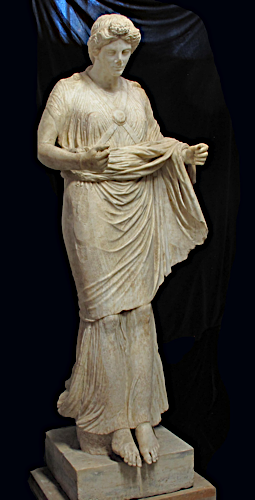
| ||
| Level 100 | ||
|
| ||
| Level 200 | ||
|
| ||
| Level 300 | ||
|
| ||
| Level 400 | ||
|
| ||
| Level 500 | ||
| ||
| Level 600 | ||
|
| ||
| Level 700 | ||
|
| ||
| History of Art | ||
| LS&A | ||
| University of Michigan | ||
| Back to the list of courses |
Hellenistic and Roman Sculpture: The Ancient Sculptural Environment from Alexander to Constantine

This course examines a broad range of forms, uses, and meanings of sculpture in public and private spaces in the Mediterranean world from the period of Alexander the Great (336-323 BC) to the reign of the Roman emperor Constantine (AD 312-337). In lectures, class discussions, and museum visits the class explores a variety of topics—from the archaeological, functional, and social contexts of sculptural works to the reconstruction of their original appearance (including their color) and their significance. Images of gods, goddesses, mythical creatures and animals mingled with portraits of public and private individuals in indoor and outdoor settings—settings that were often additionally adorned with elaborate paintings, architectural embellishments and other decorative and symbolic accouterments. These environments, in turn, provided visually rich, message-laden backdrops for the performance of social, political and cultic rituals. While analyzing the cultural work that sculptures performed in the ancient world, students also learn about Greek and Roman sculptors and about their patrons who set the agendas that these works were intended to fulfill.
This course will take advantage of a special loan exhibition, which will be on view at the Kelsey Museum of Archaeology in the Winter Term of 2016. The exhibition, "Leisure and Luxury in the Age of Nero: The Villas of Oplontis near Pompeii," includes life-size marble sculptures along with small-scale and miniature sculptures in marble, terracotta, bronze, silver, and gold. These along with sculptures in the Kelsey Museum's permanent collection will offer students' opportunities to learn firsthand about the ancient environments of such works of art and, in the special exhibition, experience them in the galleries and in navigable 3D virtual reality. No mandatory field trips outside Ann Arbor.
Textbook/Other Materials: Readings for this course will be posted on CTools.
Estimated cost of materials: $0-50.
HISTART category for concentration distributions: 1. Ancient, D.Europe and the US
This course meets the humanities distribution.